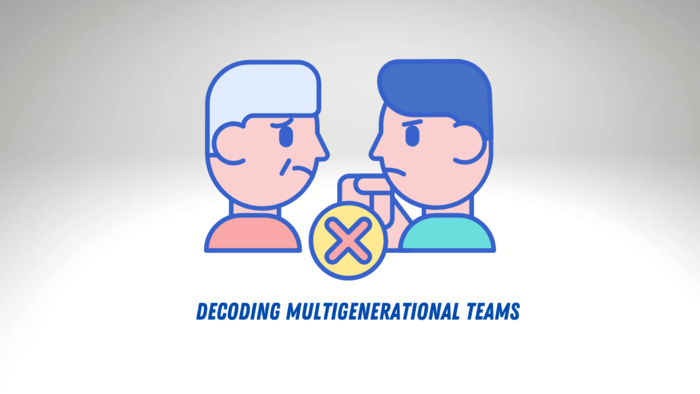Choosing the Right Diversity and Inclusion Training Agency for Your Organization
Image Description: A woman stands at the front of a room with her back to the camera. She faces a room of diverse employees sitting at tables who look forward at the far wall to view a presentation that she is providing.
By Marion Davis
In addition to partnering with recruiting agencies knowledgeable on lowering access barriers to improve diversity and inclusion, corporations can also use the services of diversity and inclusion consulting agencies. Working with consultants can allow these corporations to achieve various employee wellness and company growth goals connected to supporting a diverse workforce.
What Is Diversity and Inclusion Training?
Diversity and inclusion training is education provided to an organization that is designed to create a more inclusive and equitable workplace by increasing awareness, knowledge, and skills related to diversity. These training sessions and consulting services can take place in the form of workshops, retainer-based services, and project-based services. These services typically cover a wide range of topics, including unconscious bias, cultural competency, and the benefits of a diverse workforce. The goal is often to create a work environment where all employees feel valued, respected, and able to contribute fully to the organization’s success.
With the push for more data-driven diversity, equity, and inclusion (DEI) with measurable outcomes, companies can be selective when reviewing the countless diversity and inclusion training agencies that surged with the popularity of DEI. Companies can request various growth-focused goals and results tied in with diversity and inclusion training such as an increase in employee retention, an increase in employee-reported feelings of belonging, and an increase in talent and customers attracted from underrepresented communities.
One important point of note here is that many diversity and inclusion consultants tend to focus on particular niches within the broader spectrum of diversity. A company would do well to use the services of multiple consulting agencies. For instance, some consultants focus primarily on diversity and inclusion in terms of ethnoracial diversity while other consultants focus primarily on disability inclusion, this consulting containing practical elements such as best practices for accommodations to overcome barriers to inclusion.
To make the most of diversity and inclusion training, corporations would do well to assess their employee wellness and company reputation baseline as well as determine their goals and then use this information to guide their search for specific consulting services. Glassdoor now offers a public diversity and inclusion score where all employees can leave a rating anonymously. This score could be a helpful starting point.
How to Find the Right Diversity and Inclusion Training Agency
To find a diversity and inclusion training agency, corporations can first create a list of problems that they would like to address and the manner in which they would like to address these. For instance, some corporations may have noted that they have high attrition rates for minority employees. It is important here to look for a diversity and inclusion training agency that specializes in the particular problem addressed. As an example, many DEI consulting agencies may mention disability as part of intersectional identities but focus primarily on racial equity. These organizations might not have enough understanding of accommodations, disability inclusion, and employment law regarding disability to be able to consult appropriately if the problem a corporation is experiencing relates specifically to disabled employees. Corporations should ask for case studies from these agencies specific to similar problems solved and of the specific outcomes achieved.
Another problem encountered may be that a corporation has noted that there is a large gender pay gap within their organization. Discovering the true severity of this problem requires a diversity and inclusion training agency with a high level of statistical knowledge. Employees cannot be simply separated into gender groups and then the average pay compared. Employees must also be separated by roles, time in the company, overtime worked, and other factors. From here, diversity and inclusion training agencies can gather more qualitative data to understand the big picture and root problems. For instance, perhaps many mothers at the organization have asked for hybrid schedules to allow these women to better balance their work and caregiving duties but the organization has refused and insisted on full-time, in-person work. A training agency that specializes in data-driven gender diversity and inclusion with a successful track record in creating individualized initiatives could perhaps be more appropriate here.
Benefits Brought to the Company
There is a wide range of benefits that can be brought to companies through the use of diversity and inclusion training agencies. These benefits can include increasing employee wellness and retention, innovation revenue, the company reputation, and even access to funding from investors and organizations offering grants that are increasingly requesting diversity and inclusion plans from applicants. The following sections will review the benefits present in focusing on the inclusion of people from historically underrepresented groups. Disability inclusion is reviewed separately due to the tendency to separate diversity, equity, and inclusion (DEI) and diversity, equity, inclusion, and accessibility (DEIA) with the latter term serving as shorthand for the greater logistical and legal knowledge needed on accessibility to include people across the diverse nature of disability.
Diversity, Equity, Inclusion, and Accessibility (DEIA)
To make the most of a diverse workforce, inclusion must take place and that is where diversity and inclusion training can provide value. For example, if a corporation has a non-inclusive culture toward disabled employees, then these employees will likely not feel comfortable asking for the accommodations they need to succeed. Additionally, if corporations require a doctor’s note for every accommodation request from no-camera in meetings to the shoes an employee wears in an office setting, then they are wasting their workforce’s energy on jumping through hoops and lowering levels of morale. Common sense must prevail in supporting individual needs to perform well on the job.
Disability:IN is one company that provides virtual and on-site consulting on disability inclusion for corporations. The company notes that organizations enrolled in their Inclusion Works program have increased their new hires of disabled professionals from 339 in 2015 to 383,000 as of the end of 2023. Disability:IN presents a case for corporations holding a competitive advantage with a higher number of disabled employees. Not only do disabled employees statistically contribute high levels of creativity and thus innovation revenue to an organization, Disability:IN notes that more and more shareholders are asking for disability metrics within companies and that these metrics are playing a large part in investment considerations.
Diversity, Equity, and Inclusion (DEI)
Diversity and inclusion training that addresses racial equity, social justice for gender and sexual minorities, and other underrepresented identities are especially popular. The focus of these training sessions is typically to start with leadership and make a case for increasing belonging in an organization across all employees. The benefits of increasing feelings of belonging and demonstrating that all employees are valued are outlined by United Way of the National Capital Area as contributing to increased team cohesion and efficiency, an increase in positive public perception of the employer brand and company reputation, and again an increase in innovation revenue. The World Economic Forum noted that companies with above-average diversity metrics had 45 percent of their revenue originate from product innovation while companies with below-average diversity metrics had only 26 percent of their revenue originate from product innovation.
Points to Consider
An important point to note here is that organizations considering onboarding a third-party diversity and inclusion training agency should be cautious about the company’s adherence to employment law and guidance via data. Diversity, equity, and inclusion consulting has especially come under fire for being performative rather than focusing on the data in supporting minority employees genuinely. While determining feelings via collected qualitative data can provide helpful information, companies should track quantitative data as well.
A focus on metrics such as the profitability of the company through increased innovation revenue, decreased hiring costs, and so on can create greater inclusion and accessibility within an organization rather than a focus on appearances. Has the company experienced a dip in innovation revenue while focusing on bringing diverse team members together weekly for mandatory morale meetings, measuring success via the metric of meeting frequency, and using these meetings as photo opportunities for their talent brand on social media? Perhaps, this dip in innovation revenue is the most telling indicator here that these meetings are not–in fact–helpful and potentially are impacting employees negatively who find the meetings to be difficult due to a disability, caregiving responsibilities, and so on. This is where gathering information on feelings is important in allowing consulting agencies to better ascertain the root of the problem and to hear from the employees what they individually would find helpful.
Topics Covered in Diversity and Inclusion Training
Services offered by diversity and inclusion training agencies can range from ongoing retainers as consultants to project-based initiatives to small group workshops.
Workshops
Workshops can be especially helpful for gaining a greater understanding of a certain intersectional identity as far as employees and consumers. The Racial Equity Institute is an agency that offers a three-hour introduction to racial equity, a two-day workshop on institutional and structural racism, a two-day social justice workshop for professionals who live or work with members of Latino communities, and a two-day workshop for youths. Out & Equal is an LGBTQ inclusion agency that offers a three-part series on intersectional allyship, virtual workshops on LGBTQ inclusion and belonging, and toolkits and guides to support LGBTQ inclusion in the workplace. The Employer Assistance and Resource Network on Disability Inclusion (EARN) offers self-paced online training on core components for creating a disability-inclusive workplace.
Retainer-Based Services
Some organizations may choose to work with a third-party diversity and inclusion training agency on a retainer basis. This allows for a continuous relationship with access to resources. As a possible limitation, retaining one specific agency may tie up funds allocated to diversity and inclusion initiatives as each agency tends to have a fairly narrow focus within the broad spectrum of diversity. Potentially, considering the range of retainer fees, organizations could consider retaining multiple agencies at a lower rate. For the greatest return on investment, organizations should have certain goals in mind when exploring diversity and inclusion training agencies.
While some diversity and inclusion training agencies focus on education on minority cultures and challenges faced, an agency accustomed to achieving tangible results for companies might be a better fit for a long-term engagement. For instance, succession planning and knowledge transfer are hot topics in the human resources world. Succession planning has many benefits in that training employees to be future leaders and promoting them internally can increase employee morale and motivation, reduce hiring costs, accrue immense value from the preservation of intellectual knowledge from within the organization, and create greater stability following changes in leadership as compared to hiring externally.
Companies with the goal of benefiting from succession planning would do well to retain a diversity and inclusion training agency so that the company can work effectively with all employees in the company to provide training opportunities for future leaders. As one example, white women are the most likely out of all ethnoracial groups to seek out and benefit from senior-junior mentorship within an organization. There is a common complaint among ethnoracial minority women of lack of representation at the leadership level to provide mentorship. However, due to US demographics and cultural norms of past generations, a large portion of Baby Boomer executives will be white men. Interestingly, in a survey on the impact of such mentorship, Black women experienced the largest average salary increase correlating with mentorship at a 37.4 percent increase followed by Hispanic women at 26.3 percent.
Here, a diversity and inclusion training agency on retainer could better facilitate knowledge transfer across gender, racial, and generational groups to train future leaders within the organization. The Small Business Association’s SCORE program with retired executives provides an excellent example of where more training is needed for individuals who plan to mentor due to complaints. This program has received criticisms commonly from minority women from ethnoracial minorities to members of the disabled community about insensitive and impractical mentorship activities from assigned mentors.
Project-Based Services
In addition to workshops and retainer-based services, organizations can onboard a diversity and inclusion training agency for specific projects with deliverables.
For example, organizations may want to guide their staff in creating employee resource groups (ERGs) with community outreach goals. ERGs are support groups, typically designed for historically underrepresented employees. When done right, ERGs can attract and retain talent as well as involve initiatives that improve the company’s employer brand via community outreach. Happy employees attract happy customers, and one significant benefit of greater diversity in a company’s workforce is that these employees have strong ties to overlooked markets. Companies with above-average diversity had more than two times the cash flow of companies with below-average diversity, these companies being 70 percent more likely to identify needs within new markets.
Currently, there are resources available for leadership such as the Transformative Employee Resource Group Toolkit by Erin-Kate Escobar Consulting. However, an organization may want a custom ERG solution developed with both employee wellness and growth-based goals in mind. For instance, an organization may want to onboard a diversity and inclusion training agency that can assess baseline levels of employee retention; employee-reported feelings of belonging; and customer acquisition, demographic, and lifetime value numbers. When creating an ERG solution designed to improve employee belongingness and increase community outreach in potentially overlooked markets, the company is promoting employee happiness and sending out their employees as brand ambassadors. The deliverable here can be an ERG solution with measurable results showing increased levels of employee retention, feelings of belonging, and increased diversity and customer acquisition–among other numbers.
Typical Costs Involved in Training
Diversity and inclusion consulting services are often available in the form of monthly retainers for ongoing services ranging from an average of $2,000 to $20,000 per month, for project-based services potentially averaging $8,000 to $50,000 per deliverable such as targeted interventions or strategy developments, or for small group workshops potentially ranging from $350 to $600.
Considering the fact that diversity and inclusion consulting agencies do tend to niche within a particular corner of diversity, companies would do well to take steps to assess their baseline and identify needs to guide their pursuit of the right training for their corporation.
For instance, a common issue that disability inclusion consultants face is companies stating that they have few disabled employees working for them or that perhaps they had disabled employees but these employees could not perform and eventually quit.
Statistically, considering that more than 25 percent of the US population has a disability and this may be an invisible disability, corporations likely have employees with a chronic health condition who do not consider themselves to be disabled or who have intentionally kept their disability hidden due to fear of discrimination. Low retention rates in general across the company or specific to disabled employees at the company could be indicative of a lack of accommodations and a lack of an inclusive company culture. More than 59 percent of accommodations are free to companies and accommodations that did accrue an expense to the company were typically $500 or less.
If employees do not feel comfortable speaking up about accommodation requests due to a non-inclusive company culture, then this can create an opportunity cost for a company in not supporting the employee in contributing creatively. This failure to provide support will likely result in significant expenses due to high attrition rates.
Thus, a company that recognizes a significant problem with attrition of disabled employees, as well as the absence of openly disabled employees, may seek out a disability inclusion consulting agency specifically to address this gap within their diversity and inclusion initiatives.
Final Thoughts
Diversity and inclusion training is not a one-size-fits-all solution. This training requires a strategic, thoughtful approach tailored to the unique challenges and goals of each organization. By partnering with consulting agencies, companies can address specific needs and create a more inclusive workplace culture. Corporations should assess their baseline metrics and clearly define their objectives to find the right diversity and inclusion training agency. This could involve targeting specific issues like gender pay gaps, racial equity, and disability inclusion.
Ultimately, the benefits of effective diversity and inclusion training are profound, ranging from increased employee wellness and retention to enhanced innovation and improved company reputation. By prioritizing data-driven approaches and focusing on genuine inclusion efforts, corporations can ensure their diversity initiatives are impactful and sustainable. As the general understanding and perception of diversity and inclusion initiatives continue to evolve, companies that remain adaptable and committed to continuous improvement will be best positioned to thrive in an increasingly diverse world.
Marion Davis is a contributing writer at EmployDiversityNetwork.com. She is a disabled DEIA consultant and writes on the value of diversity and inclusion across multiple industries, specifically as relates to disability and intersectionality.














